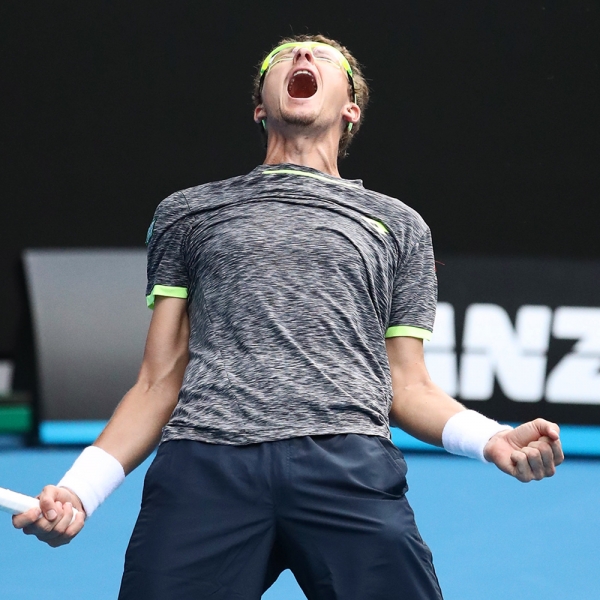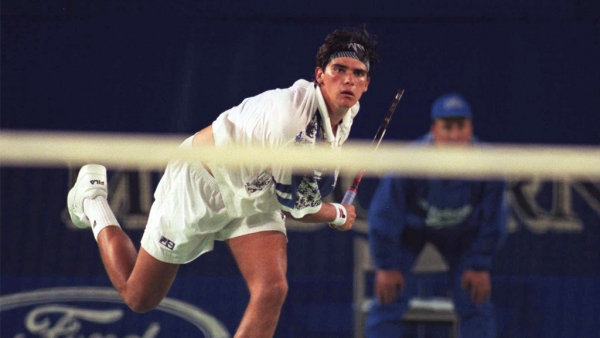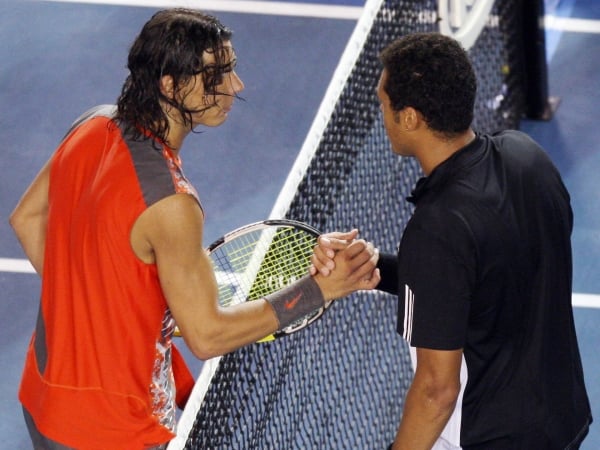It reads as the ultimate David and Goliath Grand Slam semifinal on paper – eight-time champion and top seed Novak Djokovic against a 114th-ranked qualifier on debut, Aslan Karatsev.
MORE: Match preview: Djokovic v Karatsev
However, since the Australian Open made the switch from Kooyong’s grass to the hardcourts of Melbourne Park in 1988, a slew of top-two seeds have been shown the door in momentous boilovers.
Only four years ago, Djokovic fell to a player ranked even lower than the 27-year-old Karatsev.
These are five of the biggest upsets of the top two men’s seeds at Melbourne Park.
2017: Denis Istomin d. (2) Novak Djokovic

Second round: 7-6(8) 5-7 2-6 7-7(5) 6-4
The odds may be heavily stacked against the completely unheralded Russian Karatsev on Thursday night, but Djokovic would be forgiven for an uneasy sense of deja vu heading into the showdown.
In 2017, as the second seed and six-time champion, Djokovic had easily seen off Fernando Verdasco before facing world No.117 Denis Istomin, ranked only three spots below Karatsev’s current mark.
The 30-year-old from Uzbekistan had won the Asian wild card play-off and was a former top 40 player, but had fallen in straight sets the two times he had faced Djokovic before.
In a near five-hour battle, Istomin snapped the Serb’s 15-match winning streak to hand him his earliest exit from a major since Wimbledon 2008.
“I feel sorry for Novak, because I was playing so good today,” Istomin said. "It is unreal. To beat Novak in five sets, it's a great win. I'm still feeling a little bit tired. I didn't expect to be doing what I'm doing now and what I did on the court.”
1996: Mark Philippoussis d. (1) Pete Sampras

Third round: 6-4 7-6(9) 7-6(3)
Blessed with talent to burn, big-hitting 19-year-old Mark Philippoussis was being touted as Australia’s next great hope when he set a third-round twilight showdown with world No.1 and then seven-time Grand Slam champion Pete Sampras.
In only his third main draw appearance, the world No.39 out-blasted Pistol Pete off both wings and on serve. The Scud never faced a break point and thumped 29 aces.
When Philippoussis sealed the upset on his third match point, the crowd nearly lifted the closed roof on Rod Laver Arena. The win came 20 years to the day since Australia’s last men’s singles champion, but the comedown from the euphoria of the biggest win in his career proved too much in the next round as countryman Mark Woodforde ended his run 6-2 6-2 6-2.
“Tonight was like nothing I've felt before,” Philippoussis said. “I felt so confident on the serve. I felt like I could just toss it up and hit an ace how I wanted to. It was an unbelievable feeling.”
2008: Jo-Wilfried Tsonga d. (2) Rafael Nadal

Semifinal: 6-2 6-3 6-2
The Spaniard was already a three-time Grand Slam champion and had sat comfortably as the world No.2 for more than two years when he came up against one of the most hyped French talents, 22-year-old Jo-Wilfried Tsonga, in the 2008 semifinals.
Despite falling in the first round of his lead-up event, world No.38 Tsonga had beaten seeds Andy Murray, Richard Gasquet and Mikhail Youzhny en route to his first major semifinal.
Nadal was closing in on Roger Federer’s world No.1 ranking and had easily beaten the Frenchman at the US Open four months earlier.
But he simply had no answers to the Frenchman’s powerful shot-making from all corners. Tsonga won 6-2 6-3 6-2 to reach his first and only Grand Slam final.
"It's ridiculous for sure. Everything was perfect," Tsonga said.
2002: Alberto Martin d. (1) Lleyton Hewitt

First round: 1-6 6-1 6-4 7-6(4)
Hewitt arrived at his first tournament as the new world No.1 and started a strong favourite, having won 22 of his past 23 matches on hard courts, including the 2001 US Open.
After blitzing the 39th-ranked Spaniard in the opening set, Hewitt – still recovering from a bout of chicken pox – began to struggle.
Trailing two sets to love, the Australian forced a tiebreak before Martin called for the trainer to treat cramps with the score poised at 5-4 in his favour.
Hewitt later questioned the timing of the medical timeout after he finished the match with back-to-back errors upon the resumption of play, which sealed his fate after three-and-a-half hours.
It marked the first time the No.1 seed had lost in the first round at a Grand Slam since 1990, and ended up as the first major where the top four seeds were bundled out in the opening two rounds.
"What was I supposed to do? I was cramping in both legs," Martin said. "I asked the umpire if I could call for the trainer, I didn't think I did anything against the rules. If I continued I would have been on the floor."
1989: Ramesh Krishnan d. (1) Mats Wilander
Second round: 6-3 6-2 7-6
Unheralded Indian Ramesh Krishnan had arrived in Australia with form on his side, having won a title in Auckland leading in. As the world No.51, however, he was a huge outsider against world No.1 Mats Wilander in round two of only the second Australian Open to be staged at Melbourne Park.
The Swede had won three of the four majors the year prior and was a three-time Australian Open champion. The top seed and defending champion had beaten Krishnan comfortably in the 1987 Davis Cup final.
Wilander saved match points at 5-3 and 5-4 in the third set, however the Indian closed it out with a winning volley. He proved unable to back up the win as he fell in the next round to Mexican Leonardo Lavalle.
“It’s my biggest win so far, there’s no question about that,” Krishnan said. “He hasn’t played well recently and he’s definitely not in good form.”
It was the beginning of a sharp decline for Wilander, who never reached another major final, citing the pressure of holding the No.1 ranking as being an enormous burden.